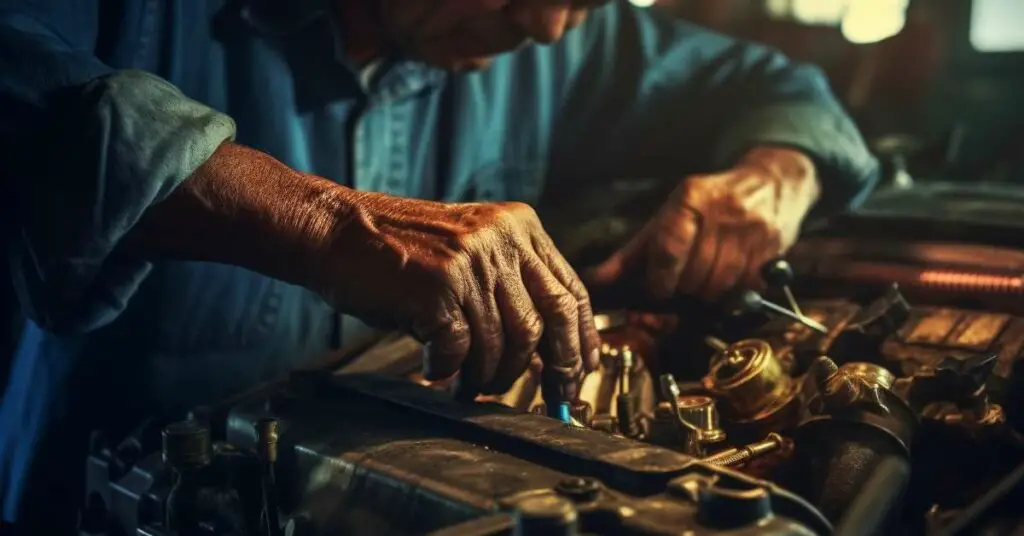
When it comes to our cars, many of us are like proud parents. We take every knock and ping to heart, and there’s no sound sweeter than a purring engine. But as much as we love our four-wheeled companions, we often overlook the less glamorous aspects of their maintenance and operation, focusing on the visible and audible while neglecting the subtle. One such often-overlooked aspect? The temperature difference between the top and bottom radiator hoses.
Understanding this seemingly arcane detail can be the key to keeping your car healthy and on the road. While it might not make your car run faster or look sleeker, this critical piece of knowledge is crucial in preventing catastrophic engine failure and expensive repair bills. To better appreciate why this matters, let’s shift gears and explore the inner workings of your car’s cooling system. Buckle up; we’re about to dive under the hood!
Understanding the Basics of a Car Radiator
The world of automobiles is a fascinating one, filled with intriguing components and systems working together to deliver that seamless driving experience we all love. One critical component, often unsung in its role, is the car radiator.
A car radiator is more than just a reservoir; it’s a vital part of the car’s cooling system. As your engine burns fuel to power your vehicle, it generates immense heat. Without an effective cooling system, this heat would soon turn your engine into a high-priced lump of scrap metal.
Enter the radiator, your engine’s personal cooling agent. It’s connected to the engine by two hoses—one at the top and one at the bottom. The top hose usually connects to the top of the radiator and flows into the engine, while the bottom hose connects to the bottom of the radiator and flows out of the engine.
But it’s not just about directing coolant flow. There’s more than meets the eye when it comes to these hoses and their temperature. The temperature difference between the top and bottom radiator hoses is an integral part of the system, and understanding this difference is like having an inside scoop on your engine’s health.
Temperature Dynamics of the Radiator Hoses
When it comes to the radiator hoses, they are not just simple conduits for coolant. Each has a unique role in maintaining the optimum operating temperature of your engine.
The top radiator hose, also known as the inlet hose, carries hot coolant from the engine to the radiator. As the engine runs, it generates heat, and the coolant absorbs this heat, thereby preventing the engine from overheating. This heated coolant then needs to be cooled down, which is where the radiator comes in.
The bottom radiator hose, or the outlet hose, plays the counterpart role. It carries the now-cooled coolant from the radiator back to the engine. The process of transferring heat from the engine to the coolant and then from the coolant to the radiator creates a natural temperature gradient between the top and bottom hoses. This gradient is not just normal but necessary for the effective functioning of the cooling system.
In simple terms, the top radiator hose is typically hotter because it carries hot coolant straight from the engine. The bottom hose is cooler because it transports the coolant after it has been cooled by the radiator. This difference in temperature is crucial to the effective operation of the car’s cooling system.
Reasons for Temperature Differences Between the Top and Bottom Radiator Hoses
Understanding the difference in temperature between the top and bottom radiator hoses requires a deeper dive into the cooling system’s mechanics. As we’ve established, the top hose is generally warmer as it transports hot coolant from the engine to the radiator. Meanwhile, the bottom hose carries cooled-down coolant from the radiator back to the engine, making it noticeably cooler. But what drives these temperature dynamics?
Role of the Thermostat: The thermostat, a small but mighty component in your car’s cooling system, plays a significant part. The thermostat’s job is to control the flow of coolant between the engine and the radiator. When the engine is cold, the thermostat stays closed, preventing coolant from flowing to the radiator. This allows the engine to warm up quickly and operate at its optimal temperature. Once the engine is sufficiently warm, the thermostat opens, allowing hot coolant to flow into the radiator via the top hose, where it cools before returning to the engine through the bottom hose.
Coolant Flow and Heat Dissipation: The heat transfer that takes place in the radiator is another crucial factor. As the hot coolant moves through the radiator’s tubes, it dissipates heat into the surrounding air. This process cools the coolant before it returns to the engine via the bottom hose. The larger the radiator and the more efficiently it dissipates heat, the cooler the coolant will be as it leaves the radiator and travels back to the engine.
Engine Heat Generation: The amount of heat your engine generates can also affect the temperature difference between the top and bottom hoses. Factors like driving style, load on the engine, and ambient temperature can all influence how hot your engine and, by extension, your coolant gets.
In summary, the temperature difference between the top and bottom radiator hoses arises due to a combination of factors, including the operation of the thermostat, the radiator’s efficiency in dissipating heat, and the engine’s heat generation.
Why is Understanding the Temperature Difference Important?
You might be wondering, “why should I care about the temperature difference between the top and bottom radiator hoses?” While it might seem like a minor detail in the grand scheme of your vehicle’s operation, this temperature differential plays a significant role in your engine’s health and performance.
Detecting Cooling System Issues: If the temperature difference between the top and bottom radiator hoses is non-existent or minimal, it might indicate a problem with the cooling system. It could mean the thermostat is stuck closed, preventing the coolant from reaching the radiator. Alternatively, it could suggest that the radiator isn’t dissipating heat effectively, causing the coolant to remain hot even after passing through the radiator.
Preventing Engine Overheating: A properly functioning cooling system is critical to prevent engine overheating. Overheating can lead to serious engine damage, including warped cylinders, blown head gaskets, and cracked engine blocks. By monitoring the temperature difference between the top and bottom hoses, you can ensure your cooling system is working correctly, thus preventing potential engine damage.
Maintaining Optimum Engine Performance: Your engine performs best at a specific temperature range. If your engine runs too hot due to a malfunctioning cooling system, it can lead to decreased performance, poor fuel efficiency, and increased emissions. On the other hand, if your engine runs too cold because the coolant isn’t getting hot enough, it can lead to increased engine wear, poor fuel efficiency, and higher emissions. Monitoring the temperature difference between the hoses can help you maintain your engine in its optimum operating range.
Longevity of the Vehicle: Regular checks on the cooling system, including understanding the temperature differential between the top and bottom radiator hoses, can help in predicting potential problems. By addressing these problems early, you can improve the lifespan of your vehicle and reduce the chances of costly repairs or replacements.
Understanding the temperature difference between the top and bottom radiator hoses can seem like a small detail, but it plays a big role in your vehicle’s overall health and performance.
How to Check the Temperature of Your Radiator Hoses
Keeping tabs on the temperature difference between your top and bottom radiator hoses is a smart way to monitor your vehicle’s health. But how do you go about it? Here’s a step-by-step guide:
Safety Precautions: First things first, safety is paramount. The cooling system operates under high temperature and pressure. Always let your vehicle cool down before you start any work on the cooling system. Never open the radiator cap while the engine is hot as it can lead to serious injuries due to scalding coolant or steam.
Required Tools: You will need an infrared thermometer. This handy tool can measure the temperature of an object without touching it, making it perfect for our task.
1. Warm Up the Engine: Start your vehicle and let it reach its normal operating temperature. You can usually tell it’s at operating temperature when the engine’s cooling fan kicks in.
2. Measure the Temperature of the Top Hose: Using your infrared thermometer, take a temperature reading of the top radiator hose. Remember, this hose should be hotter as it’s carrying hot coolant from the engine to the radiator.
3. Measure the Temperature of the Bottom Hose: Next, measure the temperature of the bottom radiator hose. This hose should be cooler, as it carries coolant from the radiator back to the engine.
4. Compare the Temperatures: There should be a noticeable difference in temperature between the two hoses. The top hose should be hotter, and the bottom hose should be cooler.
Remember, the exact temperature difference will depend on several factors, including the type of vehicle, the thermostat’s operation, and the radiator’s efficiency.
Troubleshooting Temperature Differences: When to Seek Professional Help
As a responsible car owner, understanding the temperature dynamics between the top and bottom radiator hoses can provide an early warning signal of potential issues. But what are the signs to look out for, and when is it time to bring in a professional?
Minimal or No Temperature Difference: If the temperatures of the top and bottom hoses are nearly identical or there’s no discernible difference, it may indicate a problem. This could be due to a stuck thermostat preventing the coolant from reaching the radiator, or the radiator may not be efficiently dissipating heat.
Overheating Engine: If your car’s temperature gauge indicates overheating, it’s a clear sign that something’s amiss with the cooling system. Overheating can lead to serious engine damage, so it’s best to consult a professional immediately.
Coolant Leaks: Leaks in your radiator hoses or other parts of the cooling system can lead to a drop in coolant levels, impacting the system’s ability to regulate engine temperature. If you notice coolant under your car or low coolant levels regularly, it’s time to seek professional help.
Persistent Coolant Smell: If you consistently notice a sweet, syrup-like smell while driving or after parking your vehicle, it might be due to a coolant leak. As with any leak, it’s best to have a professional take a look.
Radiator Hose Collapses: If either the top or bottom radiator hose collapses when the engine cools down, it could suggest a problem with the radiator cap or a blockage in the cooling system.
When it comes to your car’s health, vigilance and preventative care go a long way. Regular checks of the cooling system, including understanding the temperature difference between the top and bottom radiator hoses, can help predict potential problems. By addressing these problems early, you can improve the lifespan of your vehicle and avoid costly repairs or replacements.
That said, remember that every car is different. What holds true for one might not apply to another. Always refer to your vehicle’s service manual for specifications and recommendations, and when in doubt, consult with a professional mechanic.
Conclusion
From blistering summer days to frosty winter nights, the ever-reliable cooling system of our vehicles works tirelessly to keep our engines humming at just the right temperature. It’s an unsung hero of sorts, often overlooked until problems arise. But as we’ve discovered, keeping tabs on the temperature difference between the top and bottom radiator hoses is a key step towards maintaining our vehicles’ health.
Understanding this critical temperature dynamic offers a valuable insight into your car’s cooling system, signaling potential issues before they morph into costly repairs. It’s a testament to the fact that, sometimes, the devil truly is in the details. While it might not make your car go faster or look more glamorous, monitoring these temperatures can be instrumental in preventing engine damage, optimizing performance, and prolonging your vehicle’s lifespan.

As a seasoned mechanic and proud owner of three successful car workshops, I’ve dedicated my life to helping people just like you overcome their everyday automotive challenges. I created this website as a labor of love, with a simple mission: to make car maintenance and repairs more accessible and approachable for the “average joe.”
